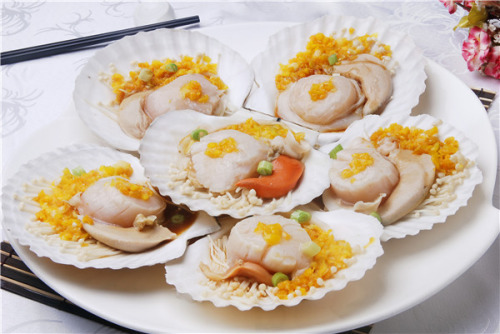
The seafood branch of Tang Palace in Beijing offers a combination of classic Cantonese with inspirations from other culinary traditions-plus Canadian lobsters. (Photo provided to China Daily)
In Beijing, sometimes it is just difficult to decide what to eat, especially with a big party of people. There are so many options and your friends' tastes may vary. But a seafood branch of Tang Palace, a Hong Kong-listed Cantonese restaurant group, never fails me, whether I'm dining alone or with a group.
The group has eight seafood branches throughout Beijing-with one more to open in September in the Wangjing area. The restaurant combines classic Cantonese with inspirations from other culinary traditions.
Chinese often say that Cantonese people will eat "everything with four legs, except tables, and everything that flies, except airplanes". That expansive culinary outlook is reflected in the thick menu, which includes crustaceans, fish, poultry, vegetables and mushrooms, plus pork dishes, such as char siu and roast suckling pig. That's not to mention dim sum.
Quite a few of the offerings are actually Sichuan-style, characterized with spiciness from red chilies and tingly numbness from Sichuan peppers, such as mixed-roots noodles with sour-and-spicy sauce, poached beef with spicy soup, Sichuan preserved sausage, and mapo tofu.
"Beijing is home to people coming from all over the country," says Wu Haiyan, an executive with the eatery group. "Not everyone likes the sweetness and light flavors of traditional Cantonese food."
However, Wu insists that all the restaurant offerings, including the spicy Sichuan-style dishes, reflect the Cantonese style of paying great attention to the freshness of ingredients, nutrition and presentation.
One of my favorite dishes in the restaurant chain is koushui chicken, or mouthwatering chicken, which may illustrate what Wu means. In the classic Sichuan version, it's dressed with chili oil, and tastes numbingly spicy and salty. At Tang Palace, it's somehow a blend of mouthwatering chicken and Cantonese poached chicken.
It's less oily than the Sichuan version and tastes very fresh. The spiciness is mild-stimulating the taste buds, but not masking the original flavor.
Upon arriving at a seafood branch of Tang Palace at midday with a party of 12, the slightly noticeable sweet smell that is typical in a Cantonese restaurant pleased our noses and teased our appetites. I soon found that the restaurant is a great place to satisfy cravings for in-season lobster, without thinning their wallets.
Since 2012, the restaurant group has been buying lobsters directly from Canada. Twice a year, when Canadian lobster harvest times come in summer and winter, Tang Palace will serve the lobster at a surprisingly cheap promotional price.


















































